Spreadsheet Add-in User's Guide for Excel
A linked reporting object is an external file, cell note, or World
Wide Web resource that you link to a cell in a Essbase database. The
file, note, or Web resource (indicated by a URL, or Uniform Resource Locator)
can then be retrieved by the Essbase Spreadsheet Add-in users who have access
to the database.
- Note:
- If your organization has licensed and implemented Essbase Partitioning
option, you can also access linked partitions from cells in Essbase
Spreadsheet Add-in. For more information on linked partitions, see "Accessing Linked Partitions".
This section describes the following procedures:
- Note:
- For additional information on using linked reporting objects, see the Essbase
Spreadsheet Add-in online help.
With the linked reporting objects feature, you can link an external file to a
data cell in Essbase Spreadsheet Add-in. Essbase stores the file on the
Essbase server. Users who have access to the database can then retrieve
the file and view the data contained in the cell.
The following example uses the Asymm.xls
sample worksheet with data from the Sample Basic database. It links a
sample file, Budasmp.txt, to a cell containing the Budget
figure. Budasmp.txt details the budgetary assumptions
for the current year.
Follow these steps to link a file to a data cell:
- Select File > Open.
- From the \essbase\client\sample directory, open the
Asymm.xls file.
- Make sure that you are connected to the Sample Basic database. If
you are not connected, see "Connecting to a Database".
- Select cell D5.
- Note:
- You can link objects only to data cells, not to cells containing member
names.
Figure 139. Selecting a Data Cell for Linking an External File
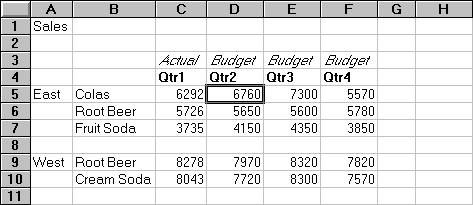
-
Select Essbase > Linked Objects.
Essbase displays the Linked Objects Browser dialog box.
Figure 140. Linking a File
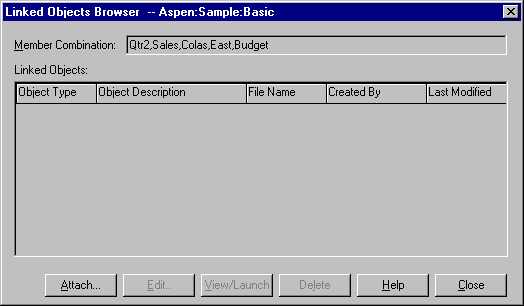
- In the Linked Objects Browser dialog box, click the
Attach button.
Essbase displays the Attach Linked Object dialog box.
- Under the Attachment Type option group, select
File.
Figure 141. Linking a File to a Data Cell
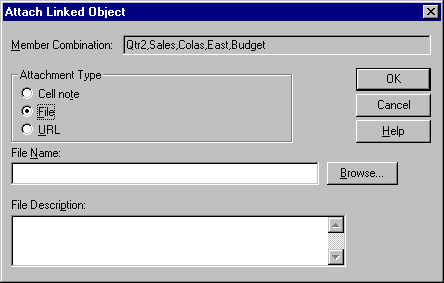
- Click the Browse button (next to the File Name text
box).
Essbase displays the Browse Files dialog box.
- Go to the \Essbase\client\sample directory and select the
Budasmp.txt file.
- Click Open.
- Under File Description, enter a brief description for the file
as indicated in Figure Figure 142.
Figure 142. Selecting and Describing a File to Link
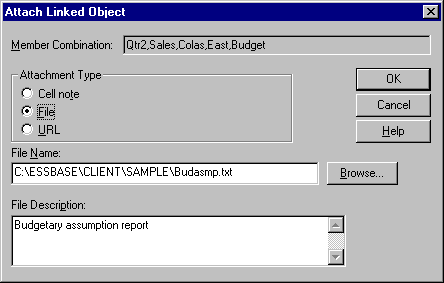
- Note:
- Entering text in the File Description text box is optional.
- Click OK to close the dialog box and link the file to the
cell.
Essbase copies the file to the server and establishes a link to the current
data cell.
- Click Close to close the Linked Objects Browser
dialog box.
- Do not close the Asymm.xls file. You
use it in the next tutorial task.
To recognize cells that have linked reporting objects attached to them, you
may want to apply a visual cue, or style, to the cells.
To apply styles:
- Select Essbase > Options and select the Style
tab.
- In the Data Cells area, select Linked
Objects.
- Click Format.
- In the Font style list box, select Italic.
- In the Color list box, select Purple. Click
OK.
- Select the Display tab.
- In the Cells option group, select the Use Styles
box. Click OK.
- Select Essbase > Retrieve to refresh the worksheet and apply
the styles.
Cell D5 (the cell you just attached the linked file to) is now displayed in
purple, italic font. Essbase also refreshes the worksheet with the
other options set in the Essbase Options dialog box.
Figure 143. Result of Applying a Style to a Linked Reporting Object Cell
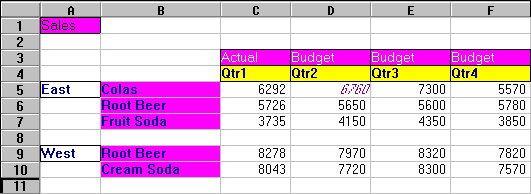
- Leave the Asymm.xls file open for the next
tutorial task.
In addition to linking external files to a data cell in Essbase Spreadsheet
Add-in, you can also link individual cell notes that contain information on
particular data cells. Cell notes can have no more than 599
characters. If you need to link information to a data cell that is
longer than 599 characters, you need to create and save an external file and
then link the file to the data cell.
To link a cell note to a data cell:
- In the Asymm.xls file, select cell C5.
- Note:
- You can link objects only to data cells, not to cells containing member
names.
- Select Essbase > Linked Objects.
Essbase displays the Linked Objects Browser dialog box.
- In the Linked Objects Browser dialog box, click
Attach.
Essbase displays the Attach Linked Object dialog box.
- Under the Attachment Type option group, select Cell
Note.
- In the Cell Note box, type the note as indicated in the
following illustration:
Figure 144. Creating a Cell Note to Link
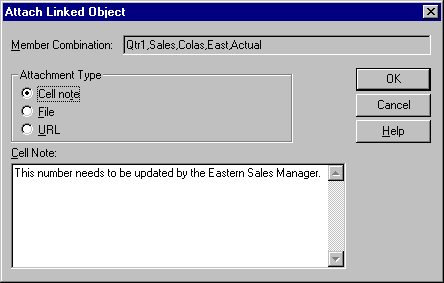
- To close the dialog box and link the cell note, click
OK.
Essbase copies the note to the server and establishes a link to the current
data cell.
- To close the Linked Objects Browser dialog box, click
Close.
- Select Essbase > Retrieve to refresh the worksheet and apply
the style you defined for linked objects.
Now Essbase displays two data cells (C5 and D5) in purple, italic font to
represent a cell that contains a linked reporting object.
Figure 145. Result of Creating a Linked Cell Note
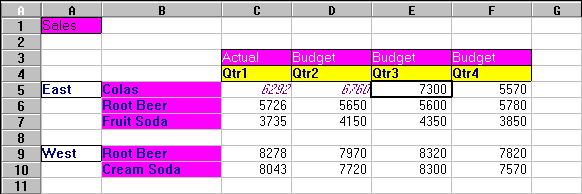
- Leave the Asymm.xls file open for the next
tutorial task.
A URL is an address string that identifies resources on the World Wide Web,
such as documents, images, and downloadable files.
With the linked reporting objects feature, you can link a URL to a data cell
so that users who have access to the database can link directly to the
specified URL. When you access the cell from Essbase Spreadsheet
Add-in, your default Web browser opens and displays the specified URL.
- Note:
- For more information on URL syntax, see the Essbase Spreadsheet Add-in online
help.
If you have a Web browser and Internet access, follow these steps to link a
data cell to the Hyperion Web site:
- In the Asymm.xls file, select cell E5.
- Note:
- You can link objects only to data cells, not to cells containing member
names.
Figure 146. Selecting a Data Cell for Linking to a URL
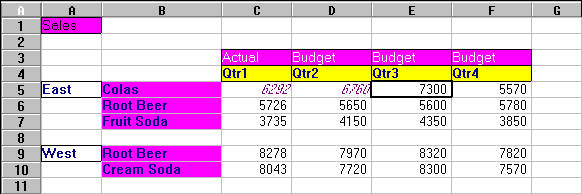
-
Select Essbase > Linked Objects.
Essbase displays the Linked Objects Browser dialog box.
- In the Linked Objects Browser dialog box, click
Attach.
Essbase displays the Attach Linked Object dialog box.
- Under the Attachment Type option group, select
URL.
Figure 147. Linking a URL to a Data Cell
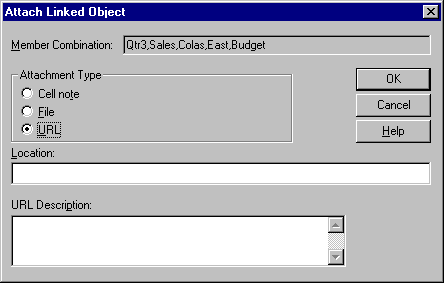
- Enter a URL in the Location text box and a brief description in
the URL Description text box, as indicated in Figure Figure 148.
Figure 148. Entering and Describing a URL to Link
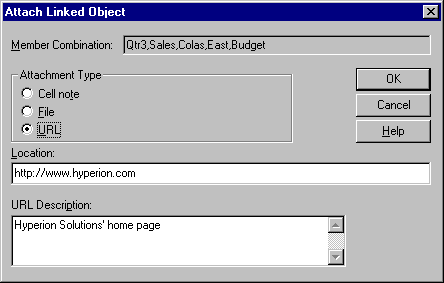
- Note:
- Entering text in the URL Description text box is optional. The text
field for entering the URL location is limited to 512 characters. The
text field for entering the URL description is limited to 80
characters.
- To close the dialog box and link the URL to the cell, click
OK.
Essbase copies the URL string to the server and establishes a link to the
current data cell.
- Note:
- The syntax for the URL is not checked at creation time; Essbase checks
the syntax when the user accesses the URL from the worksheet. The
default Web browser checks for the existence (or validity) of the URL.
- To close the Linked Objects Browser dialog box, click
Close.
- Select Essbase > Retrieve to refresh the worksheet and apply
the style that you defined for linked objects.
- Leave the Asymm.xls file open for the next
tutorial task.
Now that you have learned to create linked reporting objects, you are ready
to learn how to access them from Essbase Spreadsheet Add-in.
You have two options for accessing and editing a linked reporting object that
is attached to a data cell:
- Select the cell (as identified by the style applied to it) and select
Essbase > Linked Objects.
- Enable double-clicking for linked object browsing.
- Note:
- If you enable double-clicking for linked object browsing, double-clicking
behavior changes for retrieving data and performing drill actions. For
more information on these changes, see the Essbase Spreadsheet Add-in online
help.
For this tutorial, you access the linked reporting objects that you created
in the previous sections by using the Essbase menu item instead of the
double-clicking action.
Sometimes you want to check an external file that is linked to a data
cell.
To access the external file that you previously linked to a data
cell:
- In the Asymm.xls file, select cell D5.
- Select Essbase > Linked Objects.
- In the Linked Objects Browser dialog box, select the
Budasmp.txt file.
Figure 149. Accessing a Linked External File
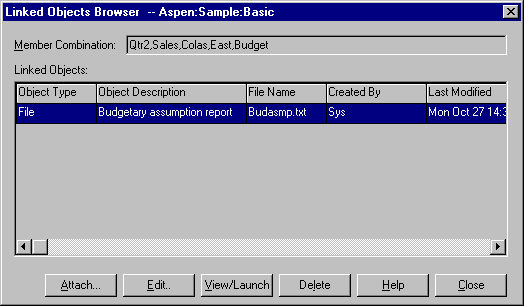
- To view the linked file, click View/Launch.
The Budasmp.txt file is opened from the source
application.
Figure 150. Viewing the Contents of a Linked External File
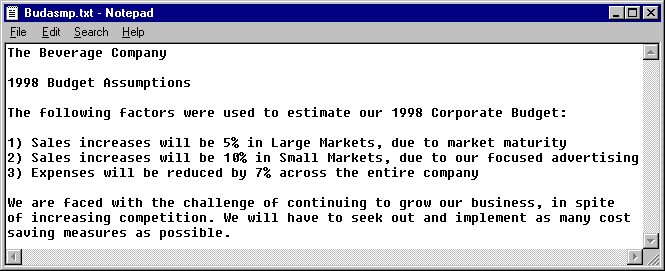
- Note:
-
Edit the contents of a file in the source application. After the edits
are made and the file saved, you can re-attach the edited file by clicking the
Edit button in the Linked Objects Browser dialog box. Essbase displays
the Re-attach Linked Object dialog box, which you can use to re-attach, or
relink, the edited file to the data cell. For more information, see the
Essbase Spreadsheet Add-in online help.
- Close the Budasmp.txt file and click Close to close the
Linked Objects Browser dialog box.
- Leave the Asymm.xls file open for the next
task.
Sometimes you have to edit a cell note that was previously created.
To access and edit the cell note that you previously created:
- In the Asymm.xls file, select cell C5.
- Select Essbase > Linked Objects.
The Linked Objects Browser dialog box displays the cell note
that is linked to the selected data cell.
- In the Linked Objects Browser dialog box, select the cell
note.
Figure 151. Accessing a Linked Cell Note
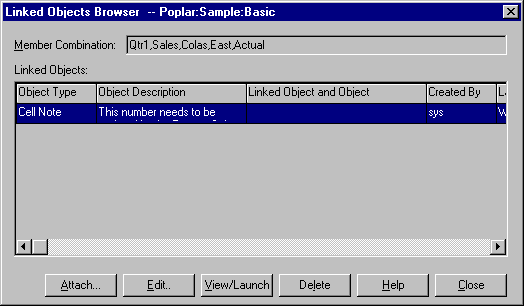
- To edit the contents of the cell note, click Edit.
Essbase displays the Edit Cell Note dialog box with the selected
cell note displayed.
Figure 152. Editing the Contents of a Linked Cell Note
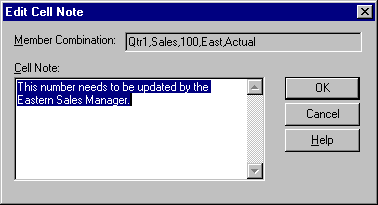
- Note:
- If you simply want to view the contents of the cell note, click the
View/Launch button instead of the Edit button in the Linked Objects Browser
dialog box.
- Edit the contents of the cell note as indicated in the following
illustration:
Figure 153. Result of Editing Cell Note Contents
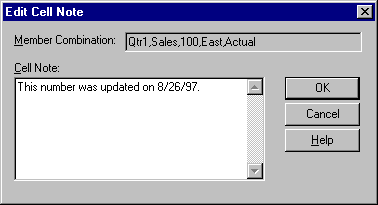
- Click OK to close the Edit Cell Note dialog box and
save the edits you made to the note.
Essbase saves the edits to the cell note on the server.
- To close the Linked Objects Browser dialog box, click
Close.
- Leave the Asymm.xls file open for the next
tutorial task.
If you followed the steps in "Linking a URL to a Data Cell", you can access and edit the URL that you created.
To access the URL:
- In the Asymm.xls file, select cell E5.
- Select Essbase > Linked Objects.
The Linked Objects Browser dialog box displays the URL that is
linked to the selected data cell.
- In the Linked Objects Browser dialog box, select the
URL.
Figure 154. Accessing a Linked URL
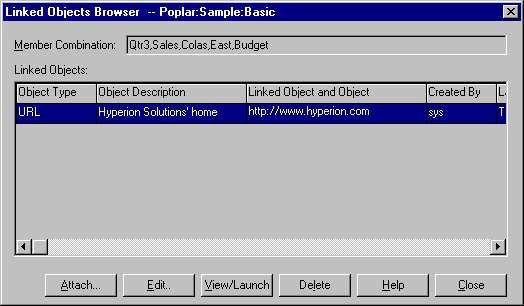
- To view the linked URL, click View/Launch.
Essbase checks the syntax of the URL. If there are syntax errors,
Essbase displays an error message. If the URL syntax is correct, the
default Web browser launches and connects to the specified site. In
this case, the syntax for the URL is correct, so the default Web browser
launches and connects to the Hyperion Web site.
Figure 155. Viewing a Linked URL
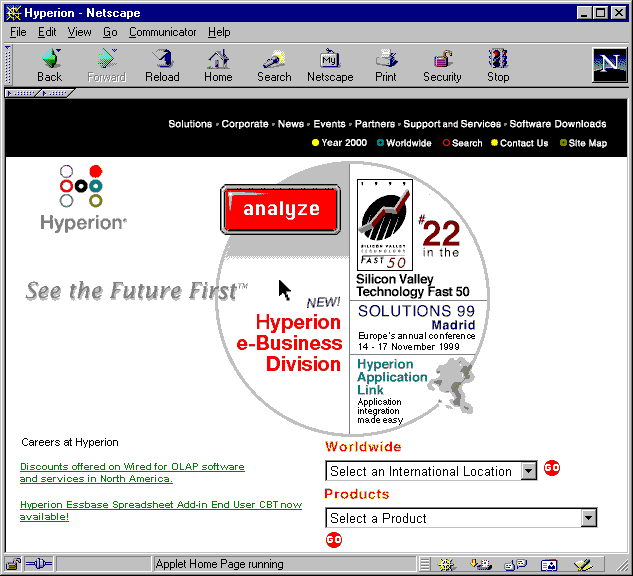
- Close the Web browser.
To edit the URL:
- In the Linked Objects Browser dialog box, select the
URL.
- To edit the linked URL, click Edit.
Essbase displays the Edit URL dialog box with the selected URL
displayed.
Figure 156. Preparing to Edit the Contents of a Linked URL
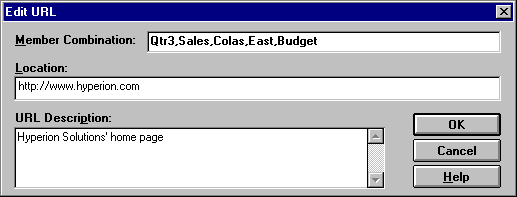
- Edit the URL location and description as show in the following
illustration:
Figure 157. Editing the Contents of a Linked URL
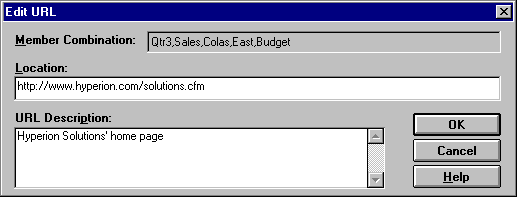
- To close the Edit URL dialog box and save the edits that you
made, click OK.
Essbase saves the edits to the URL on the server.
- To view the new URL, click View/Launch.
The Web browser launches and connects to the new URL.
Figure 158. Viewing an Edited URL
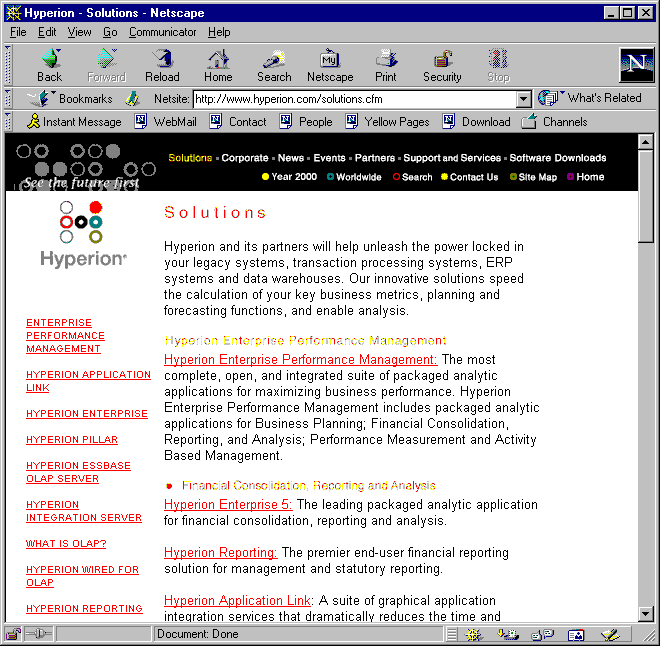
- Close the Web browser.
- To close the Linked Objects Browser dialog box, click
Close.
- Close the Asymm.xls file without saving
it.
[ Top of Page | Previous Page | Next Page | Table of Contents | Index ]



















